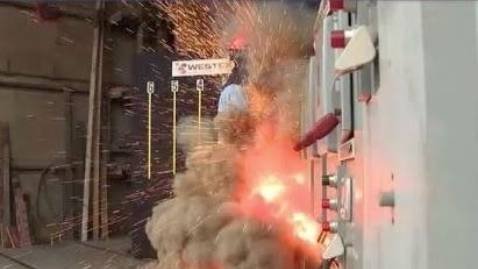Arc Flash labels
How to read them correctly
Arc Flash labels are a vital part of electrical safety on electrical equipment. They indicate the level of risk associated with a failure in the electrical system, including the possibility of electrical shock or fire. It is important that workers understand how to properly read these labels to ensure their safety and the continuity of the business.
At Alher Sem, we care about the safety of our customers and workers, and that is why we want to share some of the information that should be present on an Arc Flash label.


- Equipment Identification: The first part of the label should clearly identify the electrical equipment being referred to. This is important to ensure that workers are aware of the hazard level associated with each piece of equipment.
- Hazard Level: The label should indicate the hazard level associated with the equipment, which is measured in calories per square centimeter (cal/cm²). This number indicates the amount of thermal energy that will be released in the event of an electrical failure. It is important that workers understand this hazard level in order to take appropriate safety measures.
- Protection recommendations: The label should provide recommendations for personal protective equipment to be used in the area, such as safety glasses, gloves, and flame-retardant clothing. It is important that workers follow these recommendations to protect themselves from serious injury.
- Identification number: The label should have a unique identification number that allows workers to locate additional information about the equipment and its hazard level.
Below we present a real Arc Flash label of an industrial electrical equipment and which are its indispensable elements:

- Danger or Warning Header: Depending on the incident voltage or energy levels, a “Danger” header may be used to signal major hazards or a ” Warning” label may be used to alert to minor hazards.
- Safe working distance: Safe working distance refers to the measurement between the point of possible arc and the worker, as defined by the IEEE.
- Minimum arc energy value: Minimum arc rating refers to the amount of thermal energy measured in calories/cm² or Joules/cm² at a working distance from an arc fault.
- Arc Flash Safety Limit: This is the shortest distance point at which a worker can be permanently injured by an electric arc unless protected by suitable fire resistant clothing.
- Personal Protective Equipment (PPE): Each hazard risk level requires a different level of protection, which is rated from 1 to 4.
- Shock Hazard Approach Limits: Shock hazard approach limits are divided into “Limited Approach” and “Restricted Approach,” which are defined in detail in the Arc Flash Safety Guide for the Workplace.
- Shock risk on cover removal: This refers to the voltage level present on the equipment and the risk of electric shock that may occur if the protective cover is removed.
In summary, reading an Arc Flash label correctly is essential to ensure worker safety and business continuity. Alher Sem recommends that workers be well informed on how to read these labels and always follow the protective recommendations to avoid serious injury and property damage.
In addition, it is important to note that Arc Flash labels should be checked periodically to ensure that they are current and accurate. This can be done by a trained electrical safety professional or an in-house safety department.
At Alher Sem, we are committed to providing our customers with the most advanced and reliable electrical safety services. If you have any questions about how to read an Arc Flash label or any other aspect of electrical safety, please do not hesitate to contact us. We will be happy to assist you.
Comments
We are interested in your opinion, please leave us a comment